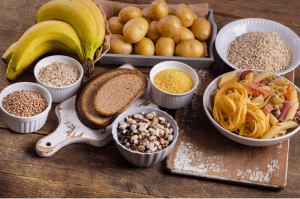Glycemic Index vs. Glycemic Load: Why It Matters for Your Diet

Carbohydrates are a hot topic when it comes to nutrition and their impact on our bodies. As our main source of energy, carbs trigger the release of insulin, a hormone that helps transport glucose into our cells to be used for energy. This is why insulin plays a key role in regulating blood sugar levels.
You’ve probably heard of simple and complex carbohydrates. The main difference between them lies in how quickly they are digested and how they affect blood sugar.
Simple vs. Complex Carbohydrates
- Simple carbohydrates are digested quickly, leading to faster spikes in blood sugar. If consumed in excess, especially refined sources like white bread, sugary drinks, and processed snacks, this can contribute to insulin resistance over time, increasing the risk of type 2 diabetes.
- Complex carbohydrates take longer to digest, providing a more steady release of energy and promoting satiety while reducing rapid blood sugar fluctuations.
Why You Don’t Need to Cut Out Simple Carbs
Many people assume they should completely eliminate simple carbs, but that’s not necessarily true. In fact, simple carbohydrates can be beneficial, especially around workouts when your body needs quick energy.
However, instead of just looking at the glycemic index (GI) of foods, it’s even more important to consider the glycemic load (GL) of an entire meal.
What Is Glycemic Load?
Glycemic load gives a more accurate picture of how a meal will affect blood sugar by considering both:
- How quickly the food raises blood sugar (glycemic index)
- The actual amount of carbohydrates in a serving
This means that the portion size matters. Even if a food has a high glycemic index, if you eat a small portion, the glycemic load might still be low. On the other hand, eating large portions of foods with a high glycemic index can significantly increase the glycemic load, causing a more substantial rise in blood sugar.
In short, glycemic load takes into account both the quality (how fast it spikes blood sugar) and the quantity (how much carbohydrate you consume) of the food, helping you better manage your blood sugar levels.

How to Balance Your Meals for Better Blood Sugar Control
A good way to balance out your meals is by pairing carbohydrates with protein and healthy fats to slow down glucose absorption and help keep your energy levels stable.
- Fruit + Mixed Nuts
- Fruit + Yogurt
- Banana Pancake (made with eggs and oats)
- Toast + Avocado
- Rice + Protein
Combining carbohydrates with fats and proteins, you spread out glucose absorption, keeping energy levels stable. This means you don’t need to eliminate simple carbs, you just need to balance them wisely! At Fit Kitchen we focus on preparing balanced meals that include protein, complex carbs, and fats. Explore our options and order online today.

